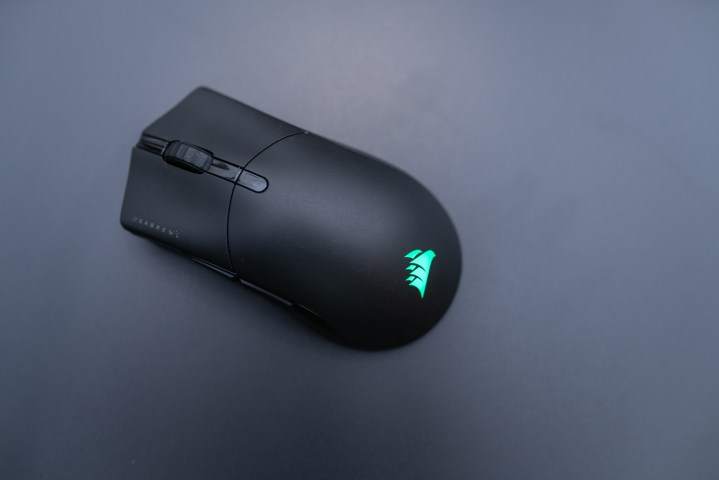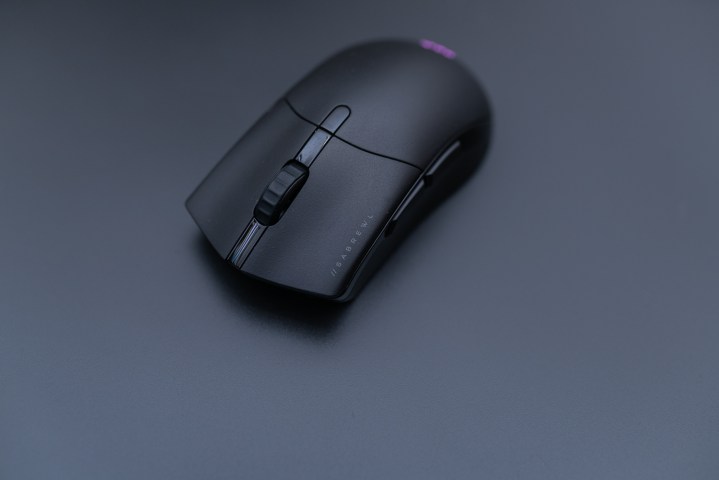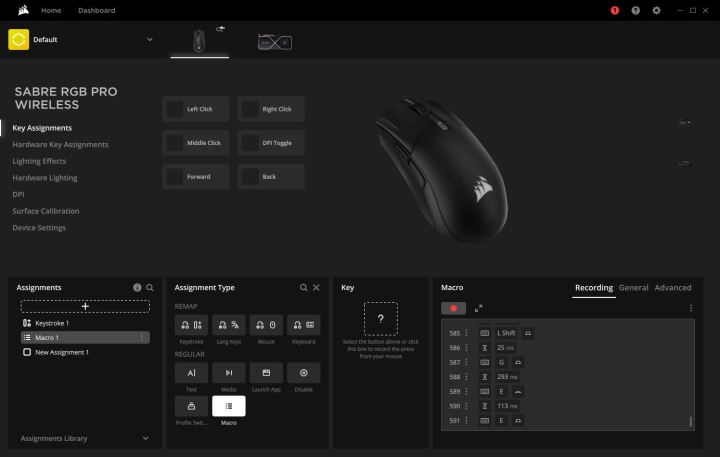“The Corsair Sabre RGB Pro Wireless has all of the features of the best wireless esports mice, just for less.”
- 2,000Hz polling rate
- Flexible iCue software
- Comfortable palm grip design
- Only 79 grams
- Two wireless modes
- Limited additional buttons
- Only one RGB zone
In the world of esports mice, it’s usually hard to get excited about another bare-bones mouse — especially when it’s an update to an existing model. That’s what the Corsair Sabre RGB Pro Wireless is. It’s nearly identical to the $60 Sabre RGB Pro, just without a wire and at nearly twice the price.
Still, it’s cheaper than the competition and comes with specs to get excited about.
You can pick up a great wireless gaming mice like the Logitech G305 for less than half the price, yes. But with an updated sensor, two wireless modes, and software that goes beyond RGB lighting, the Corsair Sabre RGB Pro Wireless is an excellent gaming mouse that undercuts the competition.
Design

The Sabre Pro Wireless comes from Corsair’s Champion Series, which is a range of products designed in collaboration with esports athletes for optimal performance. In terms of dimensions, its identical to the Sabre Pro that’s available, just with the wire snipped. The Wireless model is just a hair heavier, though — 79 grams compared to 74.
It’s not ambidextrous like the Logitech G Pro, which is the direct competitor to the Sabre Pro Wireless. Instead, the top shell is offset toward the left for a right-handed design, jutting out about 10mm more on the front. A tall middle gives you plenty to hang onto in terms of palm grip. Claw grip works, too, though I prefer something smaller like the Razer Viper Ultimate because I don’t have the biggest hands.
The Sabre Pro Wireless doesn’t need looks considering its price.
Based on looks, the Sabre Pro Wireless won’t win any awards. It’s a black mouse with a RGB Corsair logo on the back (which you can customize through iCue). It’s even more understated than the wired Sabre Pro. The Wireless model lacks lighting around the scroll wheel and nixes the DPI scale on the side of the mouse.
Still, the Sabre Pro Wireless doesn’t need looks considering its price. It’s $20 cheaper than the Logitech Pro, and $50 cheaper than the Razer Viper Ultimate. There are cheaper wireless mice like the Steelseries Rival 3, but nothing with specs to match the Sabre Pro Wireless.
Sensor and buttons
The Sabre Pro Wireless has Corsair’s Marksman 26K DPI sensor, which you can adjust in 1-DPI steps in iCue. Corsair says the mouse has a tracking resolution of 650 IPS, and you can set up to a 2,000Hz polling rate. That rate works out to 0.5ms of response time in wired mode, and Corsair claims “sub-1ms wireless transmission” with its Slipstream technology.

Compared to the wired Sabre Pro, the polling rate seems like a downgrade. The wired model supports up to an 8000Hz polling rate. Each step above 1,000Hz subdivides a millisecond, however, so the higher you go, the less return you’ll get. And 2,000Hz is fast enough, so this spec is less of a downgrade than it may seem like.
No one should reasonably use a mouse at 26K DPI, but the Sabre Pro Wireless allows you to. Wireless gaming mice like the Razer Orochi V2 top out at 18K DPI. For higher, you need to turn to flagship options from Logitech, with its 25K Hero sensor, such as the Logitech Pro X Superlight.
I used the Sabre Pro Wireless as my only mouse for about a week — and I’m still using it. As someone who puts at least a few hours into Destiny 2 each night, the Sabre Pro Wireless was able to keep up. I swapped over to my Razer Viper Ultimate and older Corsair M65 without any perceivable difference outside of shape.
Corsair says the Sabre Pro Wireless has seven programmable buttons, though I only counted six (and six only show up in iCue). In addition to left, right, and middle mouse clicks, you have a DPI adjustment button in the middle, as well as forward and back thumb buttons on the left side. You can remap any of the keys in iCue, as well as assign macros or functions to them.
No one should reasonably using a mouse at 26K DPI, but the Sabre Pro Wireless allows you to.
The left- and right click-buttons use Omron switches, which are rated for 50 million clicks. They’re Corsair’s Quickstrike buttons, too, meaning there isn’t a gap between the switch and the button. Frankly, I can’t tell a difference between it and other high-end gaming mice, so this seems mostly like marketing fluff. Omron switches are nice to have, however, and expected for a mouse in this class.
Connectivity and battery life
According to Corsair’s pricing, wireless is worth about an extra $50 on the Sabre Pro Wireless. And it is. The Slipstream wireless technology held up perfectly in a twitchy shooter like Call of Duty: Black Ops Cold War, as well as a slower action game like Resident Evil Village. Switching between wired and wireless, I couldn’t ever tell the difference.
Slipstream isn’t all you have access to, though. The Sabre Pro Wireless also works with Bluetooth 4.2, and you can swap between the two via a switch on the button of the mouse. As someone who likes to use PC peripherals on my Nvidia Shield, the Sabre Pro makes a perfect pairing with the Bluetooth-capable Logitech G915 TKL keyboard.
Corsair says the Sabre Pro can last for up to 90 hours on a charge, which is a lot longer than it sounds. I started using the Sabre Pro right away without charging. Even then, the mouse lasted a full week before it needed a charge, and it warned me that the battery was low via a small red LED on top before it died.

The battery life is 90 hours in Bluetooth mode without lighting. If you want to use Slipstream, that falls to 60 hours. Still, I never had an issue with battery life, even when using Slipstream with the lighting turned on. The mouse goes into sleep mode after 15 minutes by default, saving you some juice while you’re away.
Once the battery is out, you can plug in the included USB-C cable for charging while still using the mouse. This is something I’ve gotten accustomed to on my Razer Viper Ultimate, so I’m glad Corsair included a wired mode as well. The charging port is slightly recessed to deal with cable bulk, though I wish Corsair had pushed it back a little further. The included cable juts out about half an inch in wired mode.
Software
Bundled software is usually an afterthought, but iCue, on the other hand, is a reason to pick up the Sabre Pro Wireless. Corsair has continued to expand this software, and now, it’s better than ever. Lighting is, at least for the Sabre Pro Wireless, the least interesting part of the software.
As mentioned, you can rebind any of the six buttons. In addition to keystrokes, mouse functions, and special language keys, you can also use macros. I used the built-in macro recorder to put down a 591-step macro, and it worked. The recorder even tracks delays, allowing you to execute complex input strings with the touch of a button.

There are a huge number of possibilities in iCue. Switching between languages on your keyboard, launching apps with a button, and programming complex macros are all possible — and they’re also easy to set up in iCue.
You can segment the DPI into five profiles in iCue, which are stored on the mouse. Once you set them, you can use the mouse across machines without iCue installed. Along with DPI settings, you can organize lighting and button mappings into three onboard profiles that travel with the mouse.
There’s a lot going on in the settings, too. You can turn off the DPI adjustment, which is useful to avoid any mishaps while gaming, and you can customize the time after the mouse goes to sleep. Typical of iCue, you can also calibrate the sensor to your surface and pair the mouse again in case it gets disconnected. Out of the box, the mouse worked right away for me, even without iCue installed.
Corsair has gone deep instead of wide with iCue. Logitech’s G-Hub is useful, though not nearly as deep as iCue, and Razer has several apps that are focused on overall PC performance, not peripheral customization. Simply put, iCue is packed with functionality for peripherals while maintaining accessibility.
Our take
The Corsair Sabre RGB Pro Wireless is not for everyone. You can save a lot of money with mice like the Rival 3, which have lower specs but still hold up for the average gamer.
However, if you’re a serious esports gamer, you’ll adore the Corsair Sabre RGB Pro Wireless. With a crazy-high DPI sensor, long battery life, and a price that puts other top peripheral brands in their place, it’s an easy mouse to recommend for competitive gamers.
Are there any alternatives?
Yes. The Razer Viper Ultimate and Logitech Pro are both excellent ambidextrous mice, but they’re a little more expensive.
The Steelseries Rival 3 is a much cheaper alternative, though it doesn’t have as nice of a sensor.
How long will it last?
The Omron switches on the Corsair Sabre Pro Wireless are rated for 50 million clicks. If you clicked your mouse 10,000 a day — which is unlikely — they’d last for just under 14 years. Realistically, you’ll be able to use the Sabre Pro Wireless for over 15 years.
Should you buy it?
Yes, if you’re in the market for a high-quality wireless mouse that’s all about the basics. It depends on the types of games you play, though. Something like the Razer Naga is better for MMOs with its extra buttons, while the Corsair M65 has a stumpy design that’s easier to manage in shooters.






